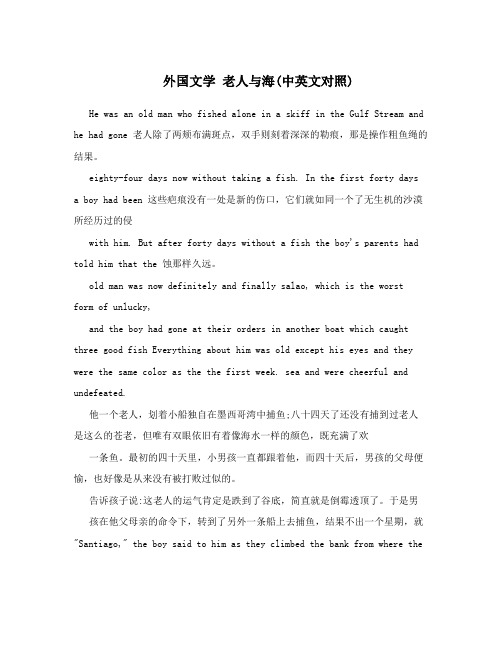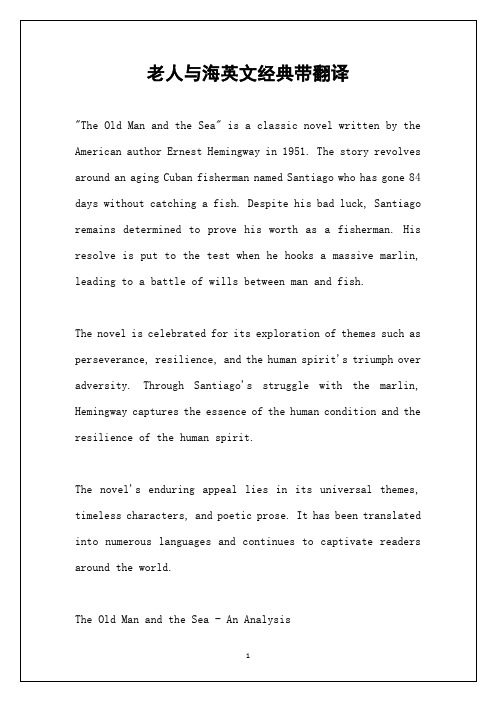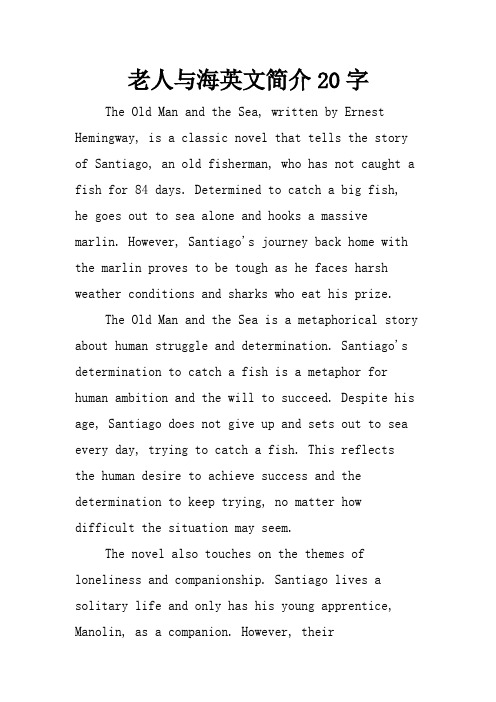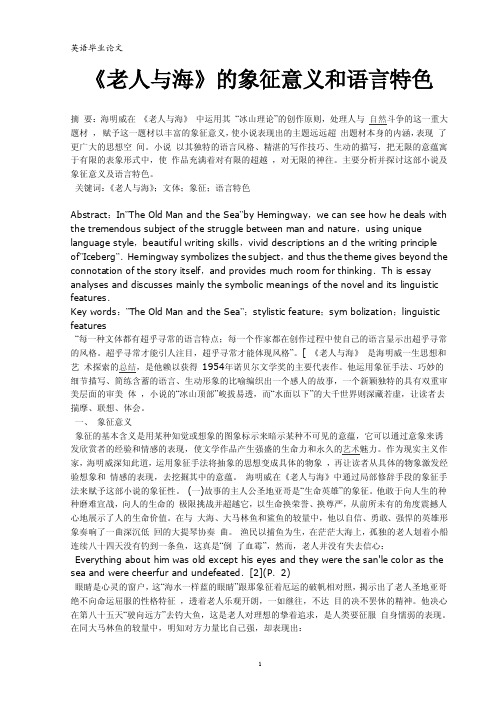老人与海象征主义英文
外国文学老人与海(中英文对照)

外国文学老人与海(中英文对照) He was an old man who fished alone in a skiff in the Gulf Stream and he had gone 老人除了两颊布满斑点,双手则刻着深深的勒痕,那是操作粗鱼绳的结果。
eighty-four days now without taking a fish. In the first forty days a boy had been 这些疤痕没有一处是新的伤口,它们就如同一个了无生机的沙漠所经历过的侵with him. But after forty days without a fish the boy's parents had told him that the 蚀那样久远。
old man was now definitely and finally salao, which is the worst form of unlucky,and the boy had gone at their orders in another boat which caught three good fish Everything about him was old except his eyes and they were the same color as the the first week. sea and were cheerful and undefeated.他一个老人,划着小船独自在墨西哥湾中捕鱼;八十四天了还没有捕到过老人是这么的苍老,但唯有双眼依旧有着像海水一样的颜色,既充满了欢一条鱼。
最初的四十天里,小男孩一直都跟着他,而四十天后,男孩的父母便愉,也好像是从来没有被打败过似的。
告诉孩子说:这老人的运气肯定是跌到了谷底,简直就是倒霉透顶了。
于是男孩在他父母亲的命令下,转到了另外一条船上去捕鱼,结果不出一个星期,就"Santiago," the boy said to him as they climbed the bank from where theskiff was 捕到了三条大鱼。
老人与海英文经典带翻译

总之,《老人与海》作为一部文学杰作,至今仍然与初次出版时一样当代和切题。海明威对人类境况的深刻探讨、普世主题以及其永恒的角色持续吸引着并激励着读者,巩固了这部小说作为世界文学永恒的经典的地位。
这部小说的持久魅力在于其普世主题、永恒的角色以及诗意的散文。它已被翻译成多种语言,在世界各地持续吸引着读者。
老人与海 - 分析
《老人与海》是对顽强的人类精神和在压倒性的困境中抵御的精神韧性的见证。通过圣地亚哥的人物形象,海明威描绘了驱使个体抵制困难并追求梦想的坚定决心和勇气。
圣地亚哥与马林鱼的史诗般的斗争是生活所呈现的挣扎和挑战的象征。尽管他所面临的障碍看似不可逾越,圣地亚哥拒绝屈从于绝望和失败。相反,他从内心的决心中汲取力量,拒绝放弃,正是这一决心代表着人类坚强不屈的精神,拒绝被摧毁。
The Old Man and the Sea - A Timeless Masterpiece
Hemingway's "The Old Man and the Sea" has earned its status as a timeless masterpiece for its profound exploration of the human condition, its universal themes, and its poignant portrayal of the triumph of the human spirit.
老人与海英文简介20字

老人与海英文简介20字The Old Man and the Sea, written by Ernest Hemingway, is a classic novel that tells the story of Santiago, an old fisherman, who has not caught a fish for 84 days. Determined to catch a big fish, he goes out to sea alone and hooks a massive marlin. However, Santiago's journey back home with the marlin proves to be tough as he faces harsh weather conditions and sharks who eat his prize.The Old Man and the Sea is a metaphorical story about human struggle and determination. Santiago's determination to catch a fish is a metaphor for human ambition and the will to succeed. Despite his age, Santiago does not give up and sets out to sea every day, trying to catch a fish. This reflectsthe human desire to achieve success and the determination to keep trying, no matter howdifficult the situation may seem.The novel also touches on the themes of loneliness and companionship. Santiago lives a solitary life and only has his young apprentice, Manolin, as a companion. However, theirrelationship is tested as Manolin's parents force him to work with a more successful fisherman. This highlights the human need for companionship and the pain of losing someone who is important to us.Hemingway's writing style is also notable in The Old Man and the Sea. He uses simple language and short sentences, which creates a sense of urgency and tension in the novel. Hemingway's writing style also focuses on the use of imagery, which allows the reader to picture scenes vividly and immerse themselves in the story.Overall, The Old Man and the Sea is a timeless novel that explores human struggle, determination, loneliness, and companionship. Hemingway's writing style and use of imagery make the story come alive, leaving a lasting impact on readers.。
英语论文89031:《老人与海》的象征意义和语言特色

《老人与海》的象征意义和语言特色摘要:海明威在《老人与海》中运用其“冰山理论”的创作原则,处理人与自然斗争的这一重大题材,赋予这一题材以丰富的象征意义,使小说表现出的主题远远超出题材本身的内涵,表现了更广大的思想空间。
小说以其独特的语言风格、精湛的写作技巧、生动的描写,把无限的意蕴寓于有限的表象形式中,使作品充满着对有限的超越,对无限的神往。
主要分析并探讨这部小说及象征意义及语言特色。
关键词:《老人与海》;文体;象征;语言特色Abstract:In”The Old Man and the Sea”by Hemingway,we can see how he deals with the tremendous subject of the struggle between man and nature,using unique language style,beautiful writing skills,vivid descriptions an d the writing principle of”Iceberg”.Hemingway symbolizes the subject,and thus the theme gives beyond the connotation of the story itself,and provides much room for thinking.Th is essay analyses and discusses mainly the symbolic meanings of the novel and its linguistic features.Key words:”The Old Man and the Sea”;stylistic feature;sym bolization;linguistic features“每一种文体都有超乎寻常的语言特点;每一个作家都在创作过程中使自己的语言显示出超乎寻常的风格。
老人与海英语介绍

Hemingway
He received the Pulitzer Prize in 1953 for The Old Man and the Sea,
and the Nobel Prize in Literature in 1954.
Plot Summary
• In a small fishing village in Cuba, Santiago, an old, weathered fisherman has just gone 84 days without catching a fish. On the 85th day, he is determined to catch a big, impressive fish. • For years, Santiago has been fishing with a young boy named Manolin. Manolin started fishing with the old man when he was only 5 years old. Santiago is like Manolin's second father, and has taught the young boy everything about fishing. Manolin is extremely loyal to Santiago and makes sure that the old man is always safe, fed and healthy. Manolin's parents, however, force the boy to leave Santiago and fish on a more lucrative fishing boat. • Manolin does not want to leave Santiago, but must honor his duty to his parents. On the new boat, Manolin catches several fish within the first few days. Santiago, meanwhile, decides to head out on the Gulf Stream alone. He feels the 85th day will be lucky for him. He sets out on his old, rickety skiff. Alone on the water, Santiago sets up his fishing lines with the utmost precision, a skill that other fisherman lack.
老人与海[中英对照]
![老人与海[中英对照]](https://img.taocdn.com/s3/m/4bcbd89df605cc1755270722192e453610665b2c.png)
老人与海(中英对照)《老人与海》是海明威的代表作,讲述了一个古巴渔村的老渔夫,在连续84天没有捕到鱼后,终于独自钓上了一条大马林鱼,但这鱼实在太大,把他的小船在海上拖了三天才筋疲力尽,被他杀死了绑在小船的一边,在归程中一再遭到鲨鱼的袭击,回港时只剩鱼头鱼尾和一条脊骨。
尽管如此,他仍然得到了人们的赞赏。
The Old Man and the Sea (English)The Old Man and the Sea is the representative work of Hemingway, telling the story of an old fisherman in a Cuban fishing village. After 84 days without catching a fish, he finally caught a big marlin alone. However, the fish was sobig that it dragged his small boat across the sea for three days before it was exhausted and killed him. It was tied to the side of the small boat on the way back, and it wasattacked sharks again and again. When he returned to the port, only the head, tail, and backbone of the fish were left. However, he still received the admiration of people.老人与海(中英对照)《老人与海》是海明威的代表作,讲述了一个古巴渔村的老渔夫,在连续84天没有捕到鱼后,终于独自钓上了一条大马林鱼,但这鱼实在太大,把他的小船在海上拖了三天才筋疲力尽,被他杀死了绑在小船的一边,在归程中一再遭到鲨鱼的袭击,回港时只剩鱼头鱼尾和一条脊骨。
老人与海英文介绍

The theme of the book is courage .
• It won the 1954 Nobel Prize for Literature. The author wants to told readers ,you will be supposed to like this old person same mind lofty aspiration, and will even better pursue even
• The gaint marlin represents trouble and foe which are on our appproaching way.
一个人并不是生来要被打败的,你尽可 以消灭它,可就是打不败它。
A man is not made for defeat ; he can be destroyed but not defeated
the fish, but with himself as well; the battle for his life, his regained
(恢复,重新获得) youth and the return of his peer's(凝视,同等) respect. For two days and two nights his adversary(对手,敌手)
resolve(决定 ,决心) to sail far out to sea in search of a catch that will redeem (恢复,挽回)his self-confidence. Early the next morning, he descends(下降) to his fishing skiff小船,舟), and rows (划船)out, into the
海鸣威 老人与海英语介绍

Impression of “The Old Man and the Sea”when I read“The Old Man and the Sea” ,I really gain something new both in the way of expression and the spirit it shows to us.The Old Man and the Sea is a story by Ernest Hemingway, written in Cuba in 1951 and published in 1952. It was the last major work of fiction to be produced by Hemingway and published in his lifetime.One of his most famous works, it centers upon Santiago, an aging Cuban fisherman who struggles with a giant marlin far out in the Gulf Stream.The Old Man and the Sea is based on the true story. After World War II, Hemingway moved to Cuba, met old fisherman Gregorio Fuentes. In 1930, Hemingway by a ship in the storm, Fuentes rescued Hemingway. Since then, Hemingway and Fuentes forged a profound friendship, and often with fishing. In 1936, Fuentes was far out to sea to catch a big fish and many things happened.This is a book about the old fisherman who lived alone in sea fishing. After the 84 days with nothing,he caught a huge marlin. It had never been seen and heard of for the old man. The fish was at least two feet longer than his boat. The fish was very large, and dragging the boat drifted for two days and nights, the elderly was in a never suffered through a difficult test in these two days and two nights. Finally the fish was stabbed and tied to the bow. However, it was unfortunate that some sharks suddenly turned up in returning, the elderly and the Shark had a desperate struggle. Finally, the giant marlin was eaten up by sharks. After some bitter, the old people dragged home only a bare and a skeleton of the injury, but he still be appreciated.The novel suggests that it is possible to transcend this natural law. In fact, the very inevitability of destruction creates the terms that allow a worthy man or beast to transcend it. It is precisely through the effort to battle the inevitable that a man can prove himself. Indeed, a man can prove this determination over and over through the worthiness of the opponents he chooses to face. Santiago finds the marlin worthy of a fight, just as he once found “the great negro of Cienfuegos” worthy. HSantiago, though destroyed at the end of the novella, is never defeated. Instead, he emerges as a hero. Santiago’s struggle does not enable him to change man’s place in the world. Rather, it enables him to meet his most dignified destiny.I t is certainly true that Santiago’s eighty-four-day run of bad luck is an affront to his pride as a masterful fisherman, and that his attempt to bear out his skills by sailing far into the gulf waters leads to disaster, Hemingway does not condemn his protagonist for being full of pride. On the contrary, Santiago stands as proof that pride motivates men to greatness. Because the old man acknowledges that he killed the mighty marlin largely out of pride, and because his capture of the marlin leads in turn to his heroic transcendence of defeat, pride becomes the source of Santiago’s greatest strength. Without a ferocious sense of pride, that battle would never have been fought, or more likely, it would have been abandoned before the end.Santiago was poor.he had nothing except a little boat and harpoon. But he said “Now is no time to think of what you do not have. Think of what you can do with what there is.”Santiago was alone. Mandolin can not go to sea with him because of his parents. He catches fishes alone. He fights with sharks alone. He can talk tonobody except himself. No one will help him.But even though he faced hungry,weary and difficulty alone, he does not give up.The old man is a great man.Although he failed for many times in his life,he never gave up. He is a steel-willing man who insisted his dream and work hard.You can destory him,but you can’t beat him.Whatever he faced to, he would never yield to the difficult, which shows a strong spirit.In our lives, I think we should learn something from the old man which will make us have a more valuable life. Whenever and wherever we meet trouble, we should never give up and try our best to overcome it. We should always keep on our dream and ma ke it come true. Everyone has his advantages and disadvantages in his life, but we sho uld face to our disadvantages, and we must be confident, which would also make us b e confident of our life. We should have faith in what we do in our life, we will have a more beautiful life in the future and our dream will come true. We should pay more att ention to what we do during our life rather than what we will get at the end because I t hink it is more important than any thing you get finally. If you enjoy you life not some thing you get, you will have a meaningful life and a noble spirit. It will hurt you when you pay more attention to what you get in the future. It will also make you do someth ing wrong which is bad for other people, our society and our country.。
- 1、下载文档前请自行甄别文档内容的完整性,平台不提供额外的编辑、内容补充、找答案等附加服务。
- 2、"仅部分预览"的文档,不可在线预览部分如存在完整性等问题,可反馈申请退款(可完整预览的文档不适用该条件!)。
- 3、如文档侵犯您的权益,请联系客服反馈,我们会尽快为您处理(人工客服工作时间:9:00-18:30)。
In Ernest Hemingway's masterpiece, The Old Man and the Sea, he uses much symbolism to assist the readers understanding of the massage he is trying to portray. The Old Man and the Sea isn't just a book about an old man and the sea. There are many hidden meanings to it. Each element represents different things. The marlin, for example, represents strength, beauty and the last challenge we all go though. The lions in his dreams resemble youth, freedom, and also strength. Santiago, the old man, symbolizes Christ in many ways and other people and things symbolize different things like the young boy, Manolin.Manolin, the young boy, that followed Santiago was not fishing with the old man because his parents forced him to, actually he was told to stay away form the old man because he was bad luck, but because he wanted too. He liked to be around the old man and listen to what he had to say. When the old man would look at Manolin he would see himself at a younger age, someone who cared more about the elderly and their heritage than the new ways bestowed on them. Manolin symbolized the disciples of Jesus. The ones who would follow him to his death and then go out and preach his ways. He believes in the old man and takes charge and tells all the other fisherman to stay away from Santiago after his return. He would take care of the old man when he said to him "Keep warm old man. Remember we are in September." Manolin only wanted good things for Santiago, he did not want anyone to hurt him or put him down for his accomplishments. He wants to learn from the old man and to listen to what he had to say about him as a young man or of Joe DiMaggio.Joe DiMaggio represents many things to the old man. Santiago sees DiMaggio as an equal. One whose father was a poor fisherman just like he is. When he was out fishing he thought to himself, would the great DiMaggio ever stay this long as he did and quickly replied to himself that DiMaggio is young and strong and that his father was a fisherman so of course he would stay. This made him feel better because now he could compare himself to his hero. Santiago thought that DiMaggio would understand him because of their background being the same. He wanted someone like the boy that would listen to him but understood him more and he believes DiMaggio could be that person. Joe DiMaggio also represents hope that the old man has for Manolin. He wishes that the boy will grow up and be like the great DiMaggio so that he will not be a poor fisher like he is.All of the other fisherman in the story are the people that want the newest equipment and want to do away with the old ways of living. They were intentionally putting down the old man and his accomplishments especiallywhen one of the fishers said to Manolin "What a fish it was. There has never been such a fish. Those were two fine fish you took yesterday too." Which Manolin did not like because he knew that it was the old man's day to shine and not his. In ways the fisherman were like the people that had to choose between setting Jesus free or a murder free and they chose the murder because they did not understand him and his ways which frightened the crowd. The fishers represent anyone who would rather think about themselves rather than others. In ways the fishers are like the sharks wanting to take things away from Santiago while Santiago is much like the marlinThe marlin represented many different things. For example, he symbolized strength and durability by putting up such a struggle. By doing this he also made Santiago a legend among the other fishermen. This struggle would be Santiago's last challenge. However, since Santiago would end up tricking the marlin, the marlin seemed more noble in Santiago's mind. Santiago thought that since the marlin was fighting for his life he had a more noble cause. Santiago thought of him as his equal, and called him "brother." The marlin could also represent the great struggle we all go through. We then must be careful of going out too far comparable to Santiago. Accomplishing or obtaining something does not always end one's journey. Once Santiago hooked the fish he still had to bring it home. Bringing home the marlin brought further complications from the sharks. The sharks could represent those who would tear apart anyone's successes. These loathsome, scavengers delight in tormenting and bringing about defeat or tragedy, similar to how some people react to other's successes. Like the marlin and the sharks, the lions also symbolized different attributes.The lions in Santiago's dreams represented his lost youth and his decreasing strength. For instance, when he needed strength on his long and strenuous voyage he thought of his dreams of the lions, and of them playing on the beach without a care in the world. With this in his mind it seemed to make him stronger and gave him the endurance to continue. The lions could also symbolize pride. Like the lions Santiago had pride. He was proud of his fishing skills. He was able to keep his lines straight and at varying levels to improve his catch of fish. He was better at this than the younger, richer, generation. Santiago knew however, that too much pride was not good. It could lead to feelings of arrogance and a know it all attitude. He was humble simultaneously with being proud. For instance he knew that he depended upon other people for food and other sustenance. Once the weather was going to turn cold Manolin was planning to bring Santiago shoes, clothes and a blanket.The author chose to not only use the various animals as symbols, but seemed to compare Santiago to Christ. Santiago had cramps in his hands from holding the fishing line all night while he and the boat were being pulled by the strong fish. Hemingway wrote that the sounds Santiago made while having the cramps were the same as the reaction "someone would have while having a nail passed through their hand and into wood." This was the same experience Christ had while being crucified. Hemingway included this reference purposefully so the reader would be able to compare and understand the similarity. After his voyage was completed Santiago was exhausted and weak. While bringing in the mast from his boat he stumbled three times under the weight resting upon his shoulders. This resembled Christ's walk carrying his heavy cross to the hill where he was crucified. Also when Santiago was back in his shack he fell asleep on his bed with his arms outstretched resembling Jesus on the cross. At this point Manolin awoke Santiago and Santiago realized he had completed his last challenge and that his time as a fisherman was up. He passed on the sword from the great fish to Manolin for continuation of the skills he had taught his apprentice. Manolin was comparable to a disciple left in charge of continuing the work the Master had started.The importance of Hemingway's story was more than just stories of animals and characters. However, Christ did his most effective teachings using stories so the common folk would understand and get the concepts of his messages. Hemingway's book was not just another "fish tale." Its' meaning was hidden among the characters and events for the reader to discover and interpret. Hemingway proclaimed however that this was not true. He stated that it was just a simple book with little meaning about a man, his boat, and a fish. However, the reader can conclude that one should not go too far without thinking of the consequences beforehand. If one does not think things through completely, the results can sometimes be worse than what was originally planned. A beautiful prize at the end of a struggle does not always end up being worthwhile, or worth what one expected.。
